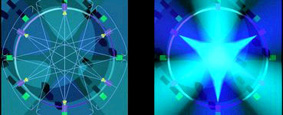

Like all operas, music is an integral part of Phase V. Despite the use of computer-aided design, synthesis and digital sampling, together with different interfacing and sound spatialization techniques, Phase V is constructed according to the ancestral rules of prodigious music, the rules at the very origin of opera.
It will be composed of two main movements, 5.1 and 5.2, uniting the four original ectasies: erotic, prophetic, telestic (phase 5.1) devoted to sensations, dedicated to agony and agitation, violence and chaos, and poetic ectasy (phase 5.2), given up to emotion, mind and introspection. Although constructed in successive phases, these phases will gradually slide one into the other, making the music seem like one long piece; the movements will be internal and not immediately perceptible as separate parts of the whole composition.
Reviving in its own way with the drunken enthousiasm of Dionysian ceremony, the machine-produced song will act by direct transmutation of the cry and the lyrics. Phase V will therefore not be interpreted by singers but by actresses (and only actresses, not actors, for a representation of the Maenads as original characters, cannibalistic and therefore able to transform into other bodies, including males). The game, released from the constraints of continuous song production, can become more theatrical, giving the preopera additional power which is normally forbidden or only partly accomplished in the operatic form.
The computer-aided music will not carry a sense, will not follow any booklet, will not be subject to the development of any story. No longer will it be the vehicle of the spoken word; its usual role as a superconductor of the sense will be refused to the voice. It will be given up to music and energy, it will rebecome just one of many other musical and scenic elements.
The text, which will appear during phase 5.2, will be displayed on video. It will first be used for essentially rhthymic purposes in the form of projections harmonized to the music. The projected words and phrases will serve to link the sensations perceived throughout the preopera to mindful reflection, a posteriori enlightening not just one sense, but several senses, thanks to the succession of the states previously experienced by the spectator.
Although support will be given to the verb, the video will not be subservient to it. First and foremost, it will develop essentially as independent, omnipresent images, never fictional or illustrative, appearing mainly in the order of the senses and thereby exempt from having to represent a concrete world. Like all the other components of the preopera, the video will originate in repetition and will progress by imperceptible variations that merge together.
Phase V will end in a peaceful exhaustion of the senses. Without a moral or epilogue, nor any final explanation, it will end in order for it to no longer be able to go on, its presence having reached the limits of the endurable.
[ next ]
